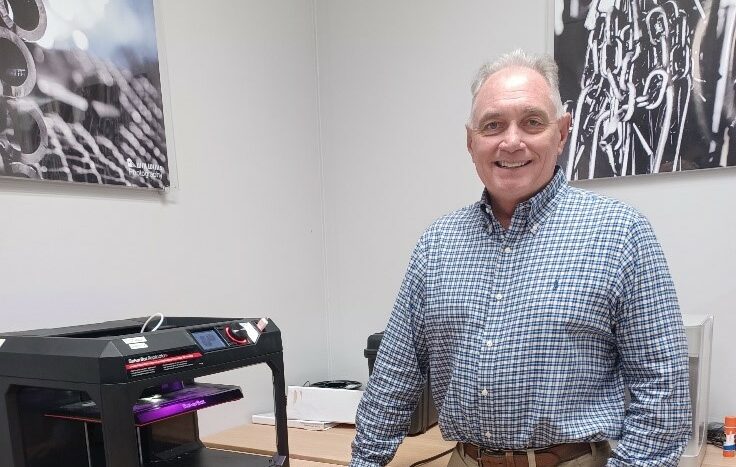
Designing Innovation for a New Generation: The Pontotoc Technology Center FabLab
October 14, 2022 by Jessika Leatherbury
By: Sunnie Dawn Baker


In 2016, administration at Pontotoc Technology Center (PTC) saw a need and had an idea to fill that need. Students were learning skills in computer drafting and CNC programming, which is a computer language which tells other computers what to do. They wanted their students to be able to experiment with these skills and actually be able to make things. They contacted Jim Lawson, the Industrial Coordinator and Manufacturing Specialist for PTC and he thought it was a brilliant idea. Thus, the Fabrication Laboratory, or FabLab, was born.
The humble beginnings of the FabLab started with a single 3D printer, but over time, with the help of grants and school funding, they have grown. They now have six 3D printers, a waterjet cutter, and a CNC router that can cut and laser etch the items. They also have a plasma cutter and welding machines available as well if they are needed. Lawson and his lab tech, Santi Turner, are there to help people use the equipment, but, really, they do so much more.
The FabLab is not just about 3D printing—it is about innovation and education—and the most amazing thing about it is that it isn’t restricted to students at PTC. Anyone in the community can use this resource through a monthly membership fee. It is Ada’s best kept secret, even though they don’t want to be a secret. The Lab provides access to members to learn about new equipment, an opportunity to refine skills, and to create new things. Every person’s needs are different, and this is one of the things that they both love most about this work. Every project is a different challenge, a different puzzle, with a different solution. But, working together, they come up with creative solutions to the problems that they face and end up doing great things.
When people utilize their services, the process begins with one-on-one instruction in the software and machines, but every person’s needs are different. As Lawson says, “We have multiple types of software in 3D modeling. It can be as simple as I can teach you in an hour how to do it, or it might take a year or so depending on how sophisticated you need your design to be.”
The problems addressed by the FabLab can be surprising and require out-of-the-box thinking. In one case, the local wildlife department came to them with a problem. They wanted to catch poachers and the idea that they had was to have a decoy deer that could roam the forests and be remote controlled. Using his knowledge of robotics, Lawson helped them create a way for them to move the decoy deer in a way that seemed realistic. They were able to utilize a 3D printer to print a few of the parts they didn’t have, but, in this case, the 3D print was one part of a larger solution.
One of the reasons why the FabLab can be so successful in helping people bring their ideas to life is the varied expertise and experience of Lawson. Growing up in Woodward, Oklahoma, Lawson came from a family that liked to work hard. His father had his own mechanic shop, and he spent his teen years working by his side, learning as he went. After he graduated high school, Lawson opened his own business—an upholstery shop—using the skills he had learned in his school shop class. He ran his business when he wasn’t working in the oil field.
After working in the oil field for a couple of years, Lawson came up with an idea for his own product that could help in the field. The problem was, he didn’t know how to make it, so he went to OSU to pursue an engineering degree. After working for General Motors and several other companies, he learned a lot about industry and manufacturing at a time when things were seriously changing. Automation was becoming more common, and 3D printing was just being invented. Lawson laughs when he recalls the infancy of 3D printing when the machine would literally lay down a piece of paper, cut it, and then stack another on top, and then another and another until the project was finished; it took a lot longer than the machines do now.
Lawson’s experience with both entrepreneurship and manufacturing also gives him a different kind of insight into how the FabLab can help all different sorts of people. If a budding entrepreneur has an idea for a product they would like to produce and eventually market, then the FabLab can help them. In addition to the technical expertise they offer, they can also assist with business consulting to help make an entrepreneur’s goals a reality.
One example where this worked well is the case of Naresh Juneja. When he was first making the prototype of his air purifier, and figuring out how to make it work best, he came to the FabLab. Juneja says, “The FabLab provided me an environment and the learning which was required to even get this journey started. Jim and Santi are great teachers and have the calm and non-judgmental attitude to help their students to visualize and complete their ideas.” Together they would experiment with different ideas and different prototypes until Juneja finally had the finished product he desired. Even to this day, if he encounters a problem, he visits his friends at the FabLab to brainstorm a solution.
Even if somebody doesn’t have a particular idea in mind for a product, they can just go, learn, and be inspired. Many of the skills acquired in the FabLab could help also people if they wanted to get a job in industry or manufacturing. Manufacturing has changed so much over the years that skills in 3D printing and design can be a major component of those careers.
The FabLab is a technical playground where people can experiment with their ideas while learning and creating. The people who come to them get the chance to do this—whether it is aviation students learning how to make model airplanes on their equipment or automotive students who need better and lighter tools printed or an innovator who wants to try out a new idea. Lawson and Turner fully embrace the creative challenges presented by the students and innovators who walk through their doors, and, with the spirit of collaboration and experimentation, they find solutions.
Anyone interested in using the FabLab can contact Pontotoc Technology Center at (580) 310-2200.
FabLab Project Examples:







Sign up to receive more news from the Ada Jobs Foundation HERE!
Written by
Jessika Leatherbury
You may also interested in:

Adapt and Overcome: Allison Poe’s Recipe for Resilience and Growth
By: Sunnie Dawn Baker Allison Poe has always followed her feet. She waits for the signs to appear and, once she recognizes them, she travels that path, and has never
Jeff Warren: A Life in Sound, Vision, and Storytelling
By: Sunnie Dawn Baker When Jeff Warren got involved in the Houston music scene as a teenager, he had no clue where his path would lead. Now, nearly thirty years
From Pitch to Progress: ECU's Glass Recycling Program Turns Waste into Opportunity
By: Sunnie Dawn Baker In 2018, Dr. Christine Pappas competed in Ada Jobs Foundation’s Big Pitch Competition by promoting grinding glass bottles into sand. She won the Big Pitch that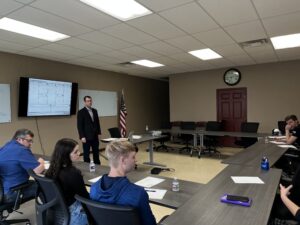
The Importance of Customer Discovery: Know Your Audience and Know Your Market
By: Sunnie Dawn Baker Entrepreneurs and small business owners must consider many factors to achieve success, with their target market being one of the most crucial. Sometimes, when people are
What Does Economic Development Do for You? The Significance of the Economic Multiplier
By: Sunnie Dawn Baker People often find the term “economic development” vague and confusing. Understanding how economic development works and benefits the community can be challenging. Though there are many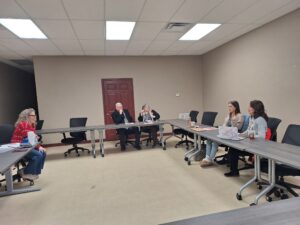
Helping Entrepreneurs One Workshop at a Time: Lauri Rowe and QuickBooks for Small Businesses
Entrepreneurs tend to be filled with passion and big ideas. They have found a solution to a problem they see in the world, and they barrel ahead, excited for their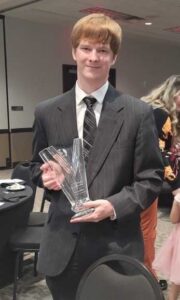
Hunter Cook: Technology, Entrepreneurship, and the Written Word
By: Sunnie Dawn Baker Hunter Cook started writing when he was seven years old. At first, he wanted to write comic books, but then he realized he couldn’t draw. He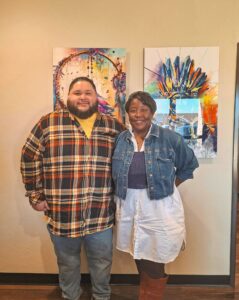
Empowering Native Artists: FAME App Brings Innovation to First American E-Commerce
By: Sunnie Dawn Baker Entrepreneurs are problem solvers. They are constantly striving for solutions to issues they see in the world or in their own lives. In the case of
Learn, Connect, and Grow: 2025 Workshops for Aspiring and Current Business Owners
By: Sunnie Dawn Baker A new year brings new possibilities, and, at the Ada Jobs Foundation, it also brings a new round of programming and workshops. As the local Economic